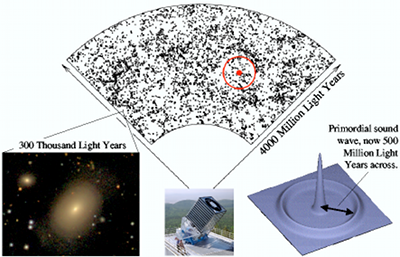Because of the approach that SDSS adopted, the project has made major impacts in studies of the dark matter in the Universe, the dark energy in the Universe, the hierarchical structure of the Universe, supermassive black holes, and the nature and distribution of stars and galaxies. In the last three areas, we expected to make progress but did not envision the extent of the impact of those studies on astronomy. In the other cases, of dark matter and dark energy, the impact was very large and was not anticipated.
3D Map of Universe Bolsters Case for Dark Energy and Dark Matter: The SDSS is two separate surveys in one: galaxies are identified in 2D images (right), then have their distance determined from their spectrum to create a 2 billion lightyears deep 3D map (left) where each galaxy is shown as a single point, the color representing the luminosity - this shows only those 66,976 our of 205,443 galaxies in the map that lie near the plane of Earth's equator.
Credit: Sloan Digital Sky Survey
The result of which I am particularly proud is that SDSS discovered the most distant supermassive black holes in the Universe. This was definitely an original goal, but it led to two discoveries that we were not targeting. Because these objects are so distant, they allow us to probe an era of the Universe in which the cold gas left over from the Big Bang is transitioning to the hot gas that we see between the galaxies today. This is now known as the transition between the cosmological Dark Ages (the time before stars) and the time when stars and quasars reionized the cold matter. We were able to pin down this event because as we looked further and further away we were able to see more and more neutral hydrogen which makes up the cold gas.
The Cosmic Yardstick: A map of the galaxies in a portion of the Sloan Digital Sky Survey (SDSS). The position of the Earth is at the bottom, represented by a picture of the SDSS telescope at Apache Point Observatory in New Mexico. Each dot marks the position of a galaxy, such as the example displayed on the left. In the first million years after the Big Bang, sound waves are driven into the cosmic gas (bottom right). SDSS researchers have used to map of galaxies to detect the remnants of these waves. The bullseye shows the present-day scale of the sound waves; however, the imprint is too subtle to see by eye.
Credit: Eisenstein, Sloan Digital Sky Survey
Another result which came early and was surprising was the discovery that we could see distortions in the shape of distant galaxies caused by the gravitational lensing of foreground galaxies. This discovery has led to an explosion of studies involving the detailed distribution of dark matter in the Universe, which is being pursued by many modern surveys.



